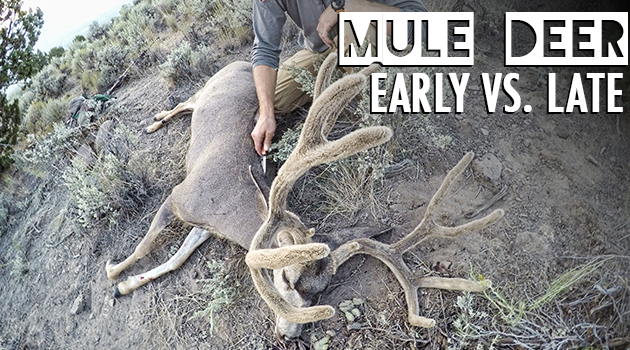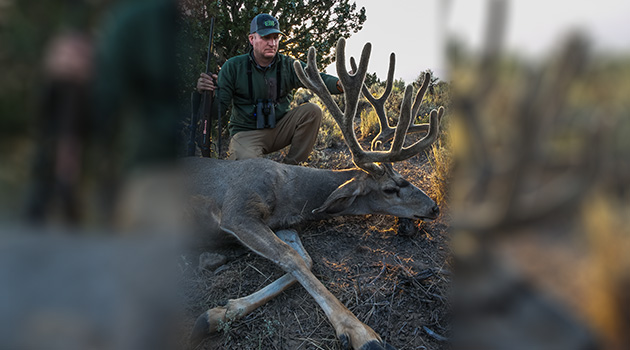As the swelled-up buck with the cheaters and dropper was ingested by an aspen grove in tow of his hot doe, I thought to myself, “I will come back here next September 10th and kill this buck on opening day of the Wyoming deer season.”
As you may have guessed, that day would never happen. Well, let’s just say September came and went to no avail. I never could turn the buck up during an open hunting season. Experience of 16 years will get you plenty of naivety and not much reality sometimes. It would be nearly 25 years later that I would only begin to fully understand the concept of mastering the art of the seasonal adjustment when it comes to deer hunting. The buck you hunt during August is not the same deer you are chasing in October, which isn’t the same deer you are in pursuit of in November. Deer change their behavior and sometimes even their location and habitat significantly through the three months of the fall season. Learning to key in on these transitions in your hunting area can increase you odds of success next season on a mature buck.
The Behavior Factor
Early-season deer are very easy to pattern during their summer mode. Until the bucks rub their velvet, they are very focused on caloric intake. These bucks are completely consumed with feeding. The only two factors beyond feed are water and cover. It’s very important to learn the food sources preferred by the bigger bucks in your hunting area. Mature bucks will often prefer to feed on different forage than the does and younger bucks will.
A common myth is that deer and cattle cannot coexist in most areas. I find this to be untrue; the cattle will often clear off the rougher browse, leaving the tender new growth available for the deer. Cattle are lazy eaters. Take advantage of this fact when you can, even on the BLM or National Forest public lands. Mule deer will not coexist with domestic sheep, however. If your favorite hunting spot is covered in “wool” this fall when you show up, go find another spot. A backup area is always a necessity.
As the fall moves along, the buck’s diet will change with the color of the leaves. As the velvet comes off and leaves begin to turn, the big bucks in your area will begin to key in on slightly different food sources and habitat. Their preferred browse will change from green grasses to a more classic buck diet of brush and browse.
As the buckbrush turns from green to orange it gets much sweeter and attracts the bucks like ticks to a dog. It turns out those old time deer hunters knew a thing or two about big bucks, hence the name “buckbrush.” Whenever I hunt a new area, I always look for large outposts of buckbrush near good cover and water. This is a great place for an otherwise hard-to-find October buck to gravitate towards. Brushy, secluded canyons make for great spots for a big, wary old mossback to stage for the rut during the last two weeks of October. More on that later…
As the fall wears on and temperatures begin to drop significantly, the bigger bucks will begin to transition to their rutting area. This transition can take weeks and cover tens of miles. This is where a big buck becomes very, very difficult to find and pattern. The final two weeks of October are probably the toughest time in the entire fall to hunt and kill a monster buck.
These seasonal changes in behavior are a very important factor to keep in mind when applying for a deer tag. Always know what type of hunt you are applying for – is it a rut hunt, a summer mode velvet hunt or possibly a tough transition hunt – which most seasons throughout the West are.
The Habitat/Terrain Factor
This is where a mild winter, wet spring and moderate summer come into play because a buck’s overall health and antler size is based on three things – age, genetics and of course, feed. As previously said, the biggest, oldest, wisest bucks will gravitate to the best feed on the mountain. Once you learn to identify these lucrative feeding areas, you will begin to unlock the secrets that a big buck has on his side.
As the fall changes, so does his feed. Where and what a buck feeds on will change as the fall drags on. During the early season a buck will be in the “green” but as the foliage burns off and turns brown/yellow, the bucks will also change their diet up a bit choosing to browse on and gravitate to the brush and tender new fall growth.
In addition to changing in his diet, a big buck will often change his terrain and habitat completely. During September a buck usually finds a high basin or a rough secluded piece of country with good feed, usually a slice of mule deer habitat that is more open in nature. As October comes around, the bucks will move more toward the heavier cover as their body chemistry begins to change and their eyes become more sensitive to the bright sunlight. It’s because of this reason that a big, mature buck is so hard to hunt in October but that’s also why the western states place their hunting seasons during this time frame. It’s a simple equation – more hunters and more revenue, less bucks killed.
Oftentimes hunters I talk to will make the fatal mistake that I made that fall day so many years ago. This mistake is the failure to understand how far a buck can travel from his summer range to his rutting area. Even in more moderate country, big bucks will travel miles to rut. This is how Mother Nature ensures the genetic purity of her mule deer. This fact was further driven home to me on two other occasions.
One September day on the heels of an early fall snowstorm in the Wyoming high country, I managed to down a big, high-country buck in the Teton Wilderness that had a small yellow ear tag in his left ear. The tag had its origins in Idaho. After a call to the Idaho Fish and Game office I was told the buck I had killed was netted and tagged as a fawn five years earlier in eastern Idaho, nearly 60 miles away. My buck’s father had nonetheless traveled nearly 60 miles to breed a doe from his summer range high atop the 10,000-foot peaks in the Tetons.
The second time was a much different case but the same result. Where I hunt in eastern Montana, the Montana Fish Wildlife and Parks was conducting a mule deer study about 10 years ago. After chatting with the biologist in charge of the collaring program, I gathered some very interesting information. In their study they had collared dozens of mule deer bucks and monitored their travel activities for an entire year. The average buck in the study traveled nearly seven miles from their summer range to their rut range. More than one of the bucks in the study had traveled over 20 miles to a rutting area – incredible, considering this is very mild and open country, but these bucks still traveled like nomads for almost no known reason.
The moral of the story here is learn the habits of the bucks in your hunting area. Big bucks are wanderers by nature and the fall is a time of transition for them. The process of scouting for big bucks is usually only lucrative for early-season hunts before the 15th of October. After that, everything changes. Just because you find a big buck in a spot in November doesn’t mean he will be there in September. Like the commercial says, “Don’t be like the naive Guy Eastman, there is a huge difference between an early-season buck and a late-season buck. They’re not the same animal. It is only after we realize this that we can begin to unlock the seasonal differences in their behaviors and habitats that will make us hunters more consistent at putting those big, wary, old bucks on the ground year after year, unless of course, they’re Popeye.”
Fall Phase Graphic:
Mule Deer- Big Buck Fall Phases
Early Summer Mode Phase (August 15th – September 10th)- The big bucks will be very predictable and gravitate to the best feed in the area, near good bedding cover and a water source within a few miles.
Early Fall Nocturnal Phase (September 10th – October 10th) – As soon as the buck sheds his velvet he will start to become very nocturnal in nature. As the feed burns off and changes he will often gravitate to the brush and secondary food sources. The deer will gravitate very close to cover and can be very hard to locate but still somewhat patternable.
Mid Fall Transition Phase (October 10th – October 25th) – This is where a big buck is the hardest to hunt. Popeye lived his entire fall in this phase. The bucks will begin to travel to his rutting area. This process is can be very slow and steady, taking weeks. These bucks are very hard to find and can be almost impossible to pattern.
Late Fall Staging Phase (October 25th – November 10th) – This is where a big buck becomes extremely difficult to locate. He is usually hiding in a very secluded hole inside cover, patiently awaiting the arrival of the rut. This is where Goliath met his demise.
The Rut (November 10th to December 10th) – This is where a big buck is the easiest to hunt. Keep in mind, these big bucks are travelers and they will move from one area to another looking for a hot doe. Bucks do not have harems like elk.
 Eastmans' Official Blog | Mule Deer, Antelope, Elk Hunting and Bowhunting Magazine | Eastmans' Hunting Journals
Eastmans' Official Blog | Mule Deer, Antelope, Elk Hunting and Bowhunting Magazine | Eastmans' Hunting Journals








Been hunting the west for over 45 years and most hunters are still wrong on the dates the rut starts, it is the last 3days of October and really gets rocking around the 3rd to 7th of November! Bet time to kill a toad is last 5days of October and first 10 days of November. If you get cold and snow even better.
Depends on the state.